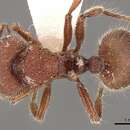en
names in breadcrumbs


Taxonomic history
Raised to species: Taylor, 1990d PDF: 34.See also: Schödl, 2007 PDF: 397.(Figs. 10, 11, 57, 80, 92)
Meranoplus diversus r. Duyfkeni [sic] Forel, 1915: 45 ( Kimberley District , Western Australia ; worker, gyne) - Taylor & Brown, 1985: 67 (catalogue), Taylor, 1987: 38 (listed), Taylor, 1990: 34 (Raised to species), Bolton, 1995: 251 (catalogue), Shattuck, 1999: 142 (listed). Lectotype worker ( MHNG , here designated), ' Typus [printed on red label] Meranoplus diversus Sm. r. Duyfkeni For. type [handwritten] Australien Mjoeberg No 33 [handwritten] Coll. A. Forel [printed] '. Fifteen paralectotypes (workers, 1 gyne in MHNG , NHMB , ANIC , MCZC and NHRS .
Remarks : Out of 14 topotypical workers and two gynes, housed in NHRS , only one worker and one gyne are labeled as types. Since it is subsequently impossible to state which of the specimens Forel had before him, only the two specimens labeled as types are here considered to belong to the original syntype series.
WORKERS (n = 8). TL 6.15 - 7.15, HL 1.50 - 1.75, HW 1.75 - 2.05, FC 1.30 - 1.48, CS 1.63 - 1.89, SL 0.90 - 1.03, SI 1 50 - 52, SI 2 53 - 56, PML 1.05 - 1.20, PW 1.32 - 1.53, PMD 1.35 - 1.60, PMI 2 100 - 105, ML 1.45 - 1.65, PTLL 0.36 - 0.45, PTLH 0.58 - 0.70, PTDW 0.49 - 0.63, PPLL 0.38 - 0.45, PPLH 0.51 - 0.70, PPI 60 - 78, PPDW 0.46 - 0.58, PT / PP 95 - 109.
Mandible with four teeth. Clypeus in full face view bluntly bidentate, additionally carinulate, dents not or only weakly surpassing anterolateral corners of frontal carinae. Head wider than long (CI 113 - 119) with the preoccipital corners evenly rounded and the rear margin concave. Frontal carinae posteriorly narrow, anteriorly broadly and translucently narrowing towards clypeus, distinctly narrower than head width (FI 131 - 139). Antennal scrobe in lateral view surpassing middle of length of head posteriorly, finely carinulate in whole length, with additional distinct microreticulum, posteriorly rather well defined from remainder of head. Genae below scrobal margin evenly carinulate to carinate, ventrolateral sides of head carinate to rugose, preoccipital lobes reticulate. Compound eyes moderate in size (EL 0.29 - 0.34, REL 0.19 - 0.20, with 17 - 18 ommatidia in the longest row) in lateral view situated slightly in front of middle of lateral sides of the head, dorsal ocular margin well separated from ventral scrobal margin.
Promesonotum trapezoid, wider than long (PMI 120 - 129), narrowly translucently margined, concealing lateral sides of mesosoma, propodeal declivity visible from above. Propodeal spines of medium length (PSL 0.50 - 0.63) situated above middle of length of declivity, acute and straight and distinctly diverging in dorsal view.
Petiole distinctly higher than long (PTI 59 - 70), in profile triangular with anterior face straight and unsculptured, the posterior face convex to angulately rounded, rugose. Postpetiole nodiform, with large ventral tooth.
First gastral tergite entirely microreticulate, with occasional interspersed glossy spots, basally an indistinct fine striation may be apparent. Dorsum of head costulate to rugose with more or less developed microsculpture, frontal margins irregularly sculptured, with pilosity consisting of decumbent arcuate short and scattered outstanding long hairs. Promesonotal shield coarsely irregularly rugose to rugoreticulate.
Concolorous brown to fuscous.
MATERIALEXAMINED
Northern Territory : Keep River National Park E Kununurra , 15. vii. 1990 ( R. P. McMillan ) . Western Australia : Derby , vi. 1984 ( G. McKenzie ), ibid. ( W. D. Dodd ) ; ' Kimberly R. S. ', iii. 1950 ( B. Rudeforth ) (19 workers in ANIC , JDMP , MCZC , NHMW , WAMP ) .
DISCUSSION
This medium sized species is readily separated from others by the unique translucently flanged promesonotal shield with projections on mesonotal hind margin directed posteriorly. Restricted to north-western Australia.